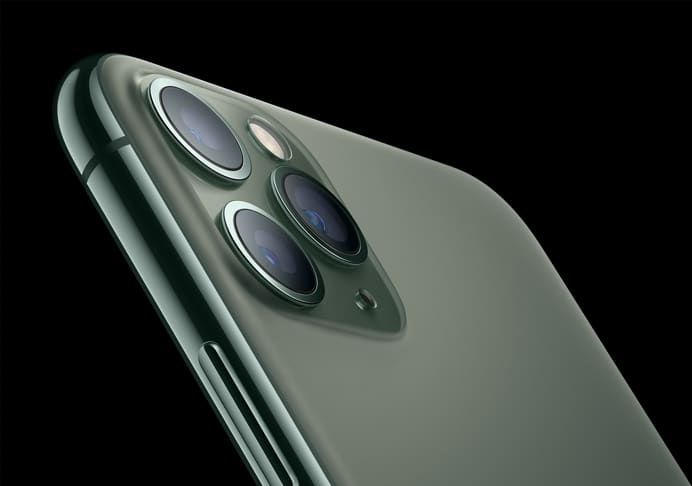Table of Contents
ToggleThe iPhone 11, iPhone 11 Pro and 11 Pro Max are finally here! This new generation is especially distinguished by the integration of a triple rear photo sensor. This year, Apple has put the package on photography. We take stock together on their price, their characteristics, design and technical sheet.

Apple has launched three new iPhone, called iPhone 11, iPhone 11 Pro, and iPhone 11 Pro Max . Three smartphones that are well on their way to becoming the new kings of the photo competing with the Huawei Mate 30 and P30 and Samsung’s latest Note 10.
Release date and price of iPhone 11

iPhone 11 Pro 64 Go
- iPhone 11 Pro: 1.159 euros
- iPhone 11 Pro Max: 1.259 euros
iPhone 11 Pro 256 Go
- iPhone 11 Pro: 1.329 euros
- iPhone 11 Pro Max: 1.429 euros
iPhone 11 Pro 512 Go
- iPhone 11 Pro: 1.559 euros
- iPhone 11 Pro Max: 1.659 euros
iPhone 11
- 64 Go : 809 euros
- 128 Go : 859 euros
- 256 Go : 979 euros
Fiche technique design iPhone 11

iPhone Pro et Pro Max
- 5.8 “and 6.5” AMOLED Super Retina XDR displays with the highest pixel density on an iPhone
- Bezel surgical steel
- SoC A13 Bionic with new machine learning controller
- 6 Go RAM
- Battery that holds the day (+ 4h compared to generation XS)
- 18W fast charge with charger included in the box!
- Triple main photo sensor: 12 Mp (26-mm, f1.8, 6 optical elements) + 12 Mp (52-mm, f2.0, 6 optical elements) + 12 Mp wide-angle 120 degrees (13-mm, f2. 4, 5 optical elements) – 4K 60 FPS video with extended HDR
- TrueDepth Sensor Kit with 4K compatible 12MP sensor and slow motion selfies
iPhone 11
- 6.1 “LCD screen
- Anodized aluminum frame
- Six new colors
- SoC A13 Bionic with new machine learning controller
- 4 Go RAM
- Battery that holds the day (+ 1h compared to the generation XR)
- Son Dolby Atmos
- Dual main photo sensor: 12 Mp (26-mm, f1.8, 6 elements) + 12 Mp 120 degrees (13-mm, f2.4, 5 optical elements) with:
- HDR extended
- New modes portrait
- Night mode (similar to Night Sight)
- 4K 60 FPS Video
- TrueDepth Sensor Kit with 4K compatible 12MP sensor and slow motion selfies
Of course in both cases, they are sold with iOS 13 .
Read Also: World Best Shopping Guidance
SoC A13 Bionic

Who says new iPhone, says new SoC: Apple has unveiled the A13 Bionic , a new chip that, according to Apple (and they are usually right) cap at the post generation A12 and Snapdragon 855 Galaxy S10 +. It should be noted that Apple has not ventured to compare its SoC Snapdragon 855+.
The SoC is engraved “in 7nm, and now has 8.5 billion transistors – against 6.9 billion on the A12 Bionic. He always has two high performance hearts and four high efficiency hearts. And it is oriented artificial intelligence. It can perform more than 1000 billion operations per second (one trillion thousand ports!).
The CPU, GPU and Neural Engine are all mobilized when it comes to machine learning. In all this SoC consumes between 30% and 40% less battery while offering 20% more performance. The GPU is also optimized for Metal, with 20% more performance and 40% lower power consumption. Finally, the Neural Engine is 20% faster while consuming 15% less energy.
Screen

The iPhone 11 Pro and 11 Pro Max are equipped with a new OLED display “Super Retina XDR” with a contrast ratio of 2,000,000: 1 and a brightness of up to 1,200 nits. The screen is 15% more energy efficient than before. The pixel density is 458 pixels per inch and the screen is still compatible HDR and Dolby Vision. Basically, this is a great step forward for the new iPhone screen compared to iPhone XS and XS Max.
Photo

On the photo side, Apple has made significant progress again. If the iPhone 11 has a “classic” double sensor at the rear of 12 MP, the main novelty comes from the iPhone 11 Pro and iPhone Pro Max. Both models have indeed a triple sensor in the back, never seen at Apple so far. There is a first module of 12MP (f / 1.8 aperture) with optical stabilization.
We also take advantage of a 12MP sensor dedicated to ultra-wide-angle shooting, which offers a field of view at 120 degrees (f / 2.0 aperture). Finally, the last 12MP telefoto module sensor (f / 2.4 aperture). Apple claims that this sensor can capture 40% more light. The front of the camera benefits from a 12 MP selfie sensor, capable of shooting in slow motion and 4K.
One of the other photo innovations is the night mode. Apple has indeed integrated its phones such a mode, like Android phones. It remains to be seen if he will be able to supplant that of Google’s Pixel 3 or Huawei’s P30 Pro.
Design




The new iPhone 11 will be available in 5 colors like the iPhone Xr including a new purple color that accompanies white, black, yellow and red. The old blue and coral colors are no longer available. The iPhone 11 Pro and 11 Pro Max are available in four colors: green, gray, silver and gold, with new textured matte finishes.
The biggest changes were made in the back. The photo sensors are housed in a new square block positioned in the upper left corner. The Apple logo is positioned perfectly in the center while it was hitherto placed a little higher. The chassis is made of stainless steel and slides between the screen and the back of the glass. Finally, in the front the design remains the same as that of iPhone XS and XS Max.
But Think is Came to First Errors from Iphone 11 Pro. This was came when compared to the Samsung Galaxy Note 10+. More About This: iPhone 11 Error Came – iPhone 11 Pro Max vs Galaxy Note 10




